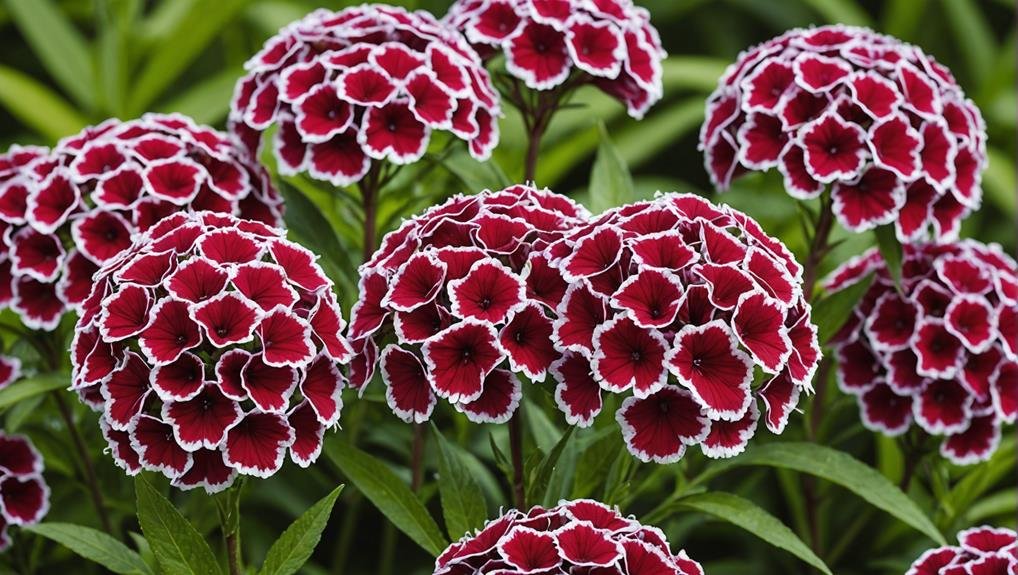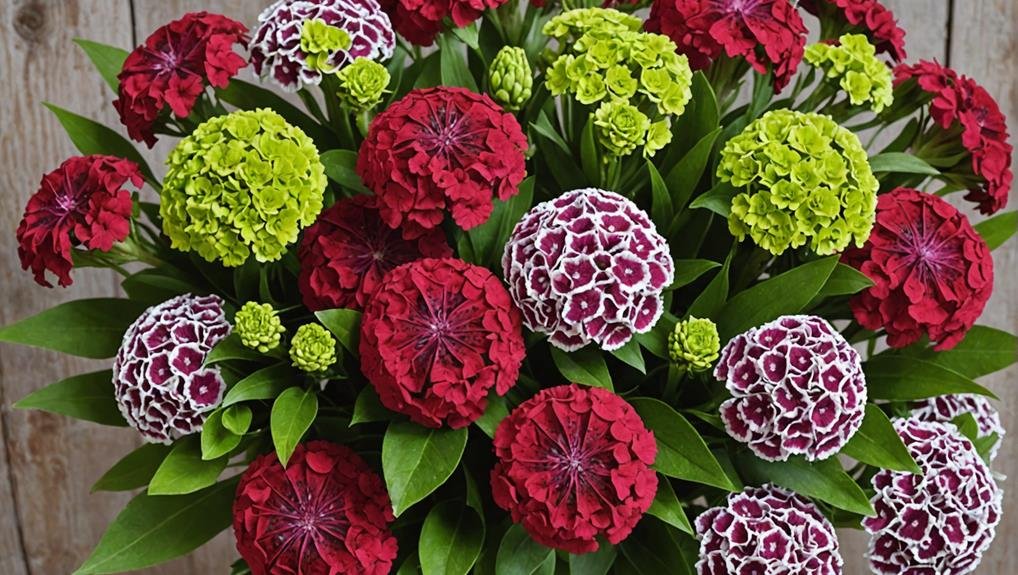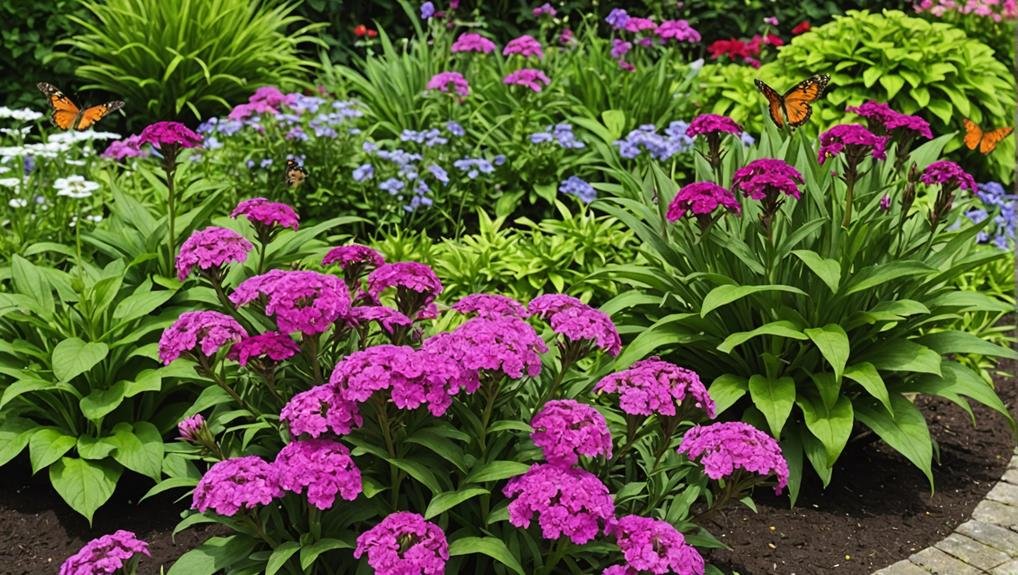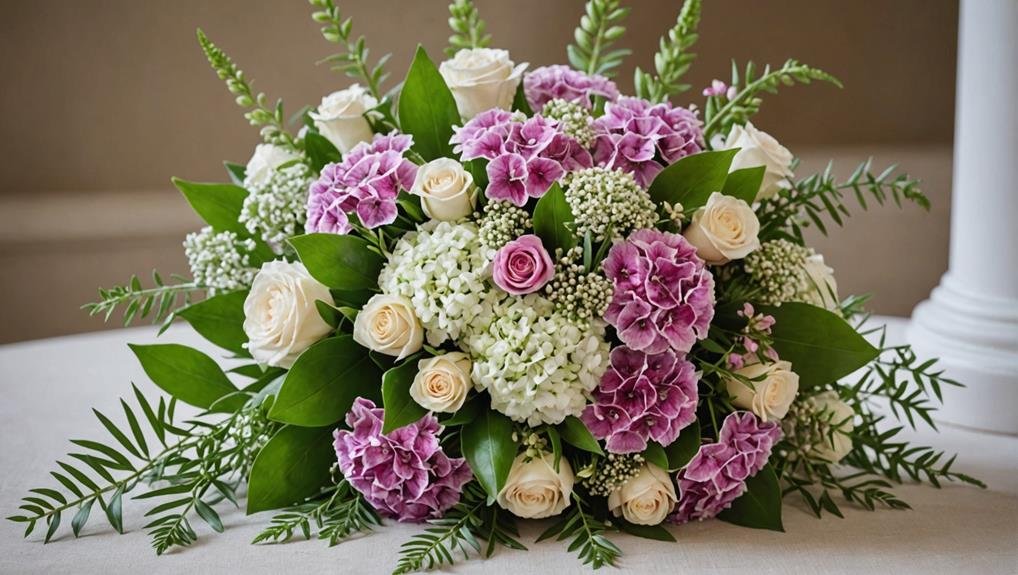The genus Dianthus, commonly known as Sweet William, offers a fascinating blend of historical significance and contemporary appeal, making it a favored choice in wedding floristry. With its origins tracing back to the monastic gardens of the 16th century, this flower is celebrated for its rich symbolism of gallantry and chivalry. Its vibrant hues and diverse bicolored varieties provide endless creative possibilities for bouquets and centerpieces. As we explore its botanical characteristics and cultural resonance, one might discover why Sweet William continues to captivate both florists and brides alike. What makes this flower an enduring emblem of elegance in wedding ceremonies?
Flower Overview

Sweet William, a vibrant and versatile flower, boasts a rich palette of hues including red, pink, violet, purple, and white. As a popular choice for wedding flowers, Sweet William brings both aesthetic charm and symbolic significance to bridal bouquets and arrangements. Known for its charming good looks, this flower can create stunning visual effects, especially with modern bicolored varieties that add a unique twist to traditional floral designs.
Sweet William's historical roots trace back to the 16th century when it was first cultivated in monastic gardens. Despite its long-standing popularity, the exact William it is named after remains a mystery. What is known, however, is its close relation to the carnation, another beloved bloom. Native to the Mediterranean, southern, and central Europe, Sweet William has become a staple in wedding decor due to its vivid colors and versatility.
Incorporating Sweet William into wedding arrangements provides a timeless yet contemporary appeal. Its various shades can complement a wide range of color schemes, making it suitable for both classic and modern wedding themes. Whether used as a focal point or as an accent flower, Sweet William enhances the beauty and elegance of any wedding celebration.
Physical Description
Characterized by its fringed petals and vibrant hues, Sweet William is a visually enchanting flower that adds a touch of elegance to any wedding arrangement. Known scientifically as Dianthus barbatus, this flower is celebrated for its charming appearance and versatility. Sweet William features an array of fringed petals that create a textured and dynamic look, enhancing the visual interest of bouquets and centerpieces.
The blooms of Sweet William come in a variety of shades, including red, pink, violet, purple, and white. Modern cultivars often boast bicolored petals, such as white and red or purple and white, adding to the flower's appeal. The intricate petal edges, or fringes, contribute to Sweet William's unique and delicate aesthetic, making it a popular choice for wedding florals.
Below is a detailed table that highlights key features of Sweet William:
| Feature | Description |
|---|---|
| Petal Texture | Fringed |
| Common Colors | Red, Pink, Violet, Purple, White |
| Bicolored Varieties | White-Red, Purple-White |
The name 'Sweet William' is thought to symbolize charming good looks, a fitting designation for a flower that adds grace and beauty to wedding arrangements. With its lively colors and distinctive fringed petals, Dianthus barbatus is a timeless addition to any floral ensemble.
Available Colour Varieties

Among the diverse range of wedding flowers, Sweet William stands out for its multitude of available color varieties. This charming flower offers a spectrum of hues that can effortlessly enhance any bridal bouquet. With colors ranging from vivid reds and delicate pinks to deep violets and elegant purples, Sweet William provides ample options to match various wedding themes and color palettes. Additionally, pure white varieties are available, perfect for creating classic and timeless arrangements.
Modern horticulture has introduced bicolored varieties of Sweet William, such as striking combinations of white and red or purple and white. These dual-tone flowers add a unique and contemporary flair to floral designs, making them a popular choice among brides looking for something distinctive. The vibrant petals of Sweet William can be mixed and matched, allowing for visually stunning displays that captivate and delight.
The versatility of Sweet William guarantees it can be seamlessly integrated into various floral arrangements, whether as a focal point in a bridal bouquet or as an accent in larger decorations. Its ability to complement other flowers while providing a splash of color makes it a favored choice for wedding florists and planners seeking to craft memorable and beautiful wedding aesthetics.
Latin Name and Taxonomy
Known for its vibrant color varieties and versatility, Sweet William, scientifically referred to as Dianthus barbatus, belongs to the dianthus family. The genus name 'Dianthus' is derived from Greek, meaning 'divine flower,' a tribute to the plant's esteemed beauty. The species name 'barbatus' translates to 'bearded,' which describes the hairy growths on the flower's petals.
Sweet William has long been a favorite among horticulturists and florists alike, partly due to its rich historical lineage. Cultivated since the 16th century, it has adorned monastic gardens for centuries. The taxonomy of Dianthus barbatus places it firmly within the Caryophyllaceae family, commonly known as the pink or carnation family. This family comprises various flowering plants known for their ornamental value and resilience.
Modern botanical classifications maintain its place in the Dianthus genus, which includes other well-known species such as the carnation (Dianthus caryophyllus) and the pink (Dianthus plumarius).
The vibrant and diverse color palette of Sweet William, ranging from reds and pinks to violets and whites, underscores its lasting appeal. Understanding its Latin name and taxonomy not only enriches our appreciation but also provides insight into its enduring charm in floral arrangements.
Geographical Origins

Originating from the Mediterranean region and central Europe, Sweet William has a rich geographical heritage that spans southern Europe and parts of Asia. This vibrant flower, scientifically known as Dianthus barbatus, has been cultivated for centuries, finding a prominent place in gardens across the British Isles since the 16th century. Renowned for its vivid colors and delightful fragrance, Sweet William has become a staple British garden plant, admired for both its aesthetic appeal and historical symbolism.
Sweet William's symbolism dates back to Victorian times when it signified gallantry and bravery. This tradition continues today, as evidenced by the Duchess of Cambridge, who included Sweet William in her wedding bouquet to symbolize charm and gallantry. Over the years, the flower has not only graced countless gardens but has also carried significant cultural meanings.
Below is a table summarizing key aspects of Sweet William's geographical origins and cultural significance:
| Region | Historical Significance | Symbolism |
|---|---|---|
| Mediterranean | Ancient cultivation | Gallantry, bravery |
| Central Europe | 16th-century British gardens | Charm, historical symbolism |
| Southern Europe | Traditional European gardens | Aesthetic and cultural value |
| Asia (parts) | Early horticultural practices | Varied cultural symbolism |
| British Isles | Popular since the 16th century | Charm, gallantry in weddings |
The geographical origins of Sweet William and its enduring symbolism make it a cherished choice for wedding bouquets and garden landscapes alike.
Season Availability
In addition to its rich historical and cultural significance, Sweet William also boasts a seasonal availability that spans from late spring to early fall, making it an ideal choice for weddings during these months. This extended blooming period allows couples to incorporate these charming flowers into their wedding plans with confidence, knowing they are at their peak beauty and freshness.
Sweet William flowers are particularly noted for their vibrant colors, which range from deep reds and pinks to pure whites and purples. This wide array of hues ensures that they can complement a variety of wedding themes and styles. The flowers' versatile color palettes make them suitable for various floral arrangements, from classic bouquets to modern centerpieces.
To help visualize Sweet William's season availability and its benefits, consider the following points:
- Prime Blooms: Available from late spring to early fall.
- Vibrant Colors: A spectrum of reds, pinks, whites, and purples.
- Versatile Color Palettes: Ideal for diverse wedding themes.
- Peak Freshness: Guarantees lasting beauty throughout the wedding day.
The combination of Sweet William's seasonal availability and its stunning, versatile color palettes makes it a top choice for creating memorable and elegant wedding floral arrangements.
Growing Conditions

Sweet William thrives best under full sun exposure, although it can endure partial shade with some compromise on bloom quality. For ideal growth, this flowering plant requires well-drained loamy soil with a slightly alkaline pH level. Ensuring proper soil drainage is vital to meet Sweet William's water requirements, as regular watering is necessary. However, gardeners should take care to avoid overwatering, which can lead to root rot and other related issues.
In addition to these essential growing conditions, Sweet William plants are known for their tendency to spread quickly. As a result, occasional thinning may be necessary to maintain vibrant and healthy growth, preventing overcrowding and ensuring each plant receives adequate sunlight and nutrients. This practice helps in sustaining the overall health and visual appeal of the garden.
Adjustments to the soil structure, such as incorporating organic matter or sand, may be needed to improve drainage and meet the plant's specific needs. By paying attention to these growing conditions, gardeners can cultivate Sweet William successfully, resulting in an abundance of colorful, fragrant blooms that are ideal for enhancing any wedding arrangement or floral display.
Cultural Significance
The cultural significance of Sweet William flowers is deeply rooted in their historical associations with gallantry, bravery, and chivalry. These symbolic meanings have made Sweet William a cherished choice in various cultural contexts, particularly as a representation of admiration and respect.
Historically, Sweet William gained prominence during the Victorian era, where the language of flowers, also known as floriography, was used to convey emotions and messages that could not be spoken aloud. Sweet William's symbolism in the language of flowers includes:
- Gallantry: Representing a chivalrous and honorable demeanor.
- Bravery: Embodying courage and valor.
- Chivalry: Signifying courteous behavior and a knightly spirit.
- Admiration: Expressing deep respect and affection.
The cultural significance of Sweet William is further exemplified by its inclusion in significant events. For instance, Duchess Kate Middleton incorporated Sweet William into her bridal bouquet, highlighting the flower's historical connotations of bravery and chivalry. This choice underscores the depth and meaning that Sweet William adds to wedding floral arrangements.
Moreover, the rich history and enduring symbolism of Sweet William enhance not only its aesthetic appeal but also the emotional resonance of the events it graces. This multifaceted cultural significance makes Sweet William a timeless and meaningful addition to any floral composition.
Typical Use in Weddings

Beyond its cultural significance, Sweet William has become a quintessential element in wedding floral arrangements for its vibrant colors and enduring symbolism. This flower is frequently used by florists to create stunning wedding bouquets, table centerpieces, and other decorative Floral Arrangements. The rich hues of Sweet William, which range from vivid reds and pinks to delicate violets and whites, make it a versatile choice that can complement a wide array of wedding themes and color schemes.
The long vase life of Sweet William, typically lasting between 5-10 days, further enhances its practicality for wedding decorations. Brides often choose Sweet William not only for its aesthetic appeal but also for its historical connotations of gallantry and Victorian charm. The inclusion of Sweet William in Duchess Kate Middleton's bridal bouquet, for instance, has cemented its status as a flower of significance and elegance.
Here is a table to illustrate the typical uses of Sweet William in weddings:
| Typical Use | Description |
|---|---|
| Bridal Bouquets | Adds color and symbolism to the bride's ensemble |
| Table Centerpieces | Enhances the aesthetic appeal of dining tables |
| Floral Archways | Creates memorable entrances and photo backdrops |
| Boutonnieres | Provides a touch of elegance for grooms and groomsmen |
Incorporating Sweet William into wedding floral arrangements guarantees a blend of tradition, beauty, and lasting charm.
Alternative Flower Types
Exploring different flower varieties for weddings opens up a world of possibilities to suit various themes and personal preferences. When considering alternative flower types, matching the blooms with the season of your wedding is crucial to ensure freshness and availability.
For summer weddings, some exceptional choices beyond the traditional Sweet William include:
- Peonies: Recognized for their lush, full blooms and wide range of colors, peonies add an element of elegance and romance to any summer wedding.
- Delphiniums: These flowers provide striking vertical accents with their tall, spiky blooms and come in vibrant shades of blue and purple.
- Freesia: With their delicate, bell-shaped blossoms and sweet fragrance, freesias make a superb addition to bouquets and centerpieces.
- Roses: Available in numerous colors, roses are timeless classics that can be customized to complement any wedding theme.
Autumn weddings can benefit from the rich hues and textures of dahlias and gladioli, while winter weddings might feature unique elements like berried ivy and amaryllis.
Each season offers a distinct palette and variety of flowers, allowing couples to create a personalized and unforgettable floral arrangement. By exploring these different flower varieties, you can discover the perfect blooms to enhance the beauty and atmosphere of your wedding day.
